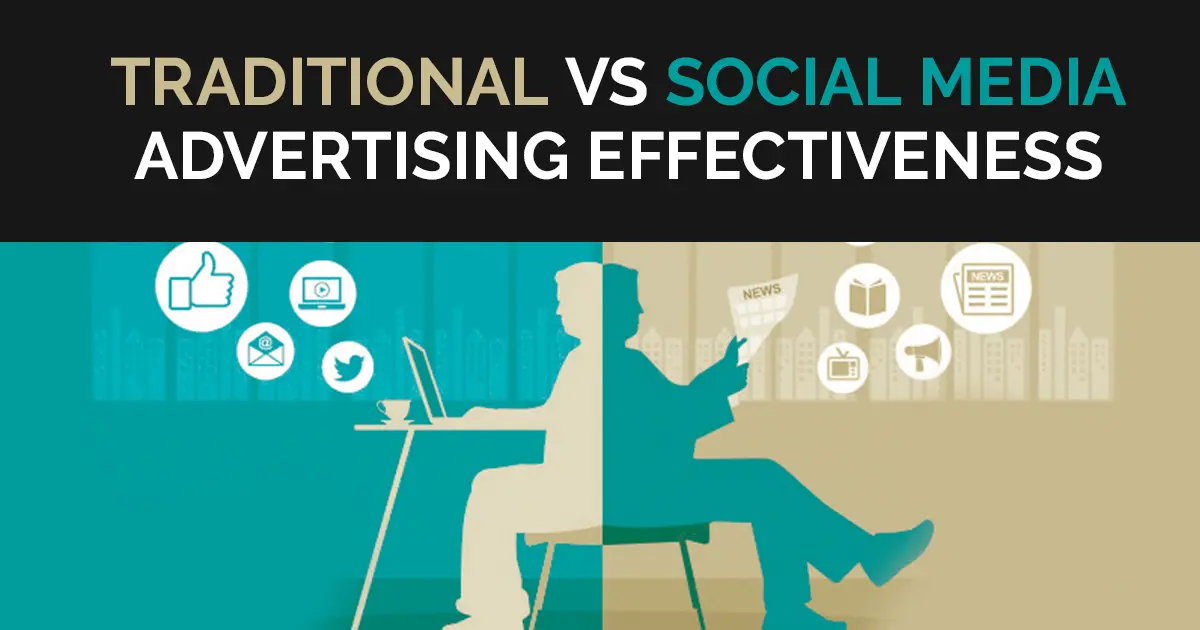In today’s digital landscape, businesses have an array of advertising options at their disposal. Two prominent avenues are traditional advertising and social media advertising campaigns.
Both approaches offer unique benefits and drawbacks, making it crucial for marketers to understand their differences and choose the most effective strategy to invest their advertising budget wisely.
In this article, we will compare traditional advertising and social media advertising, highlighting their respective pros and cons to help you make an informed decision.
Traditional Advertising
Benefits of Traditional Advertising:
- Wide Reach: Traditional advertising methods, such as television, radio, and print media, have the potential to reach a broad audience. This is particularly advantageous for businesses targeting a diverse customer base.
- Established Credibility: Traditional advertising channels have been around for decades, building trust and credibility among consumers. Seeing an ad on television or in a reputable publication can enhance brand perception and create a sense of legitimacy.
- Tangible Presence: Traditional advertising often provides a tangible presence through physical mediums like billboards, newspapers, or direct mail. This can leave a lasting impression and engage customers who prefer tangible marketing materials.
Cons of Traditional Advertising:
- Limited Targeting: Traditional advertising lacks the precise targeting capabilities offered by digital platforms. Marketers have less control over reaching specific demographics, resulting in potential ad wastage and decreased efficiency.
- High Cost: Traditional advertising campaigns can be expensive, especially for prime time television slots or full-page magazine ads. Smaller businesses with limited budgets may find it challenging to compete with larger brands in traditional advertising spaces.
- Difficult Measurement: Measuring the success of traditional advertising can be challenging. It’s often difficult to track the direct impact of traditional ads on sales or customer engagement, making it harder to assess the return on investment (ROI).
Social Media Advertising
Benefits of Social Media Advertising:
- Precise Targeting: Social media platforms offer robust targeting options, allowing businesses to reach specific demographics, interests, behaviors, and locations. This precise targeting increases the likelihood of reaching the right audience, resulting in higher conversion rates.
- Cost-Effective: Social media advertising campaigns can be tailored to fit any budget. Whether you have a small or large advertising budget, social media platforms provide flexible options to reach your target audience without breaking the bank.
- Real-Time Analytics: Social media advertising offers in-depth analytics and real-time insights. Marketers can track ad performance, measure engagement, and make data-driven decisions to optimize campaigns for better results.
Cons of Social Media Advertising:
- Platform Saturation: Social media platforms are crowded spaces, making it increasingly challenging for businesses to stand out and capture user attention. It requires creativity and strategic targeting to break through the noise.
- Ad Blocking: Some users employ ad-blocking software or simply ignore ads on social media, reducing the overall effectiveness of campaigns. Advertisers must find innovative ways to grab attention and provide value to overcome this challenge.
- Rapid Changes: Social media platforms frequently update their algorithms and ad policies, requiring marketers to stay agile and adapt their strategies accordingly. This constant evolution can be demanding and time-consuming.
Choosing the Best Approach
When deciding how to invest your advertising budget, consider the following factors:
- Target Audience: Understand your target audience’s demographics, behaviors, and preferences. If they primarily engage with traditional media, such as television or print, traditional advertising may be more suitable. If they are active on social media platforms, focus on social media advertising to reach them effectively.
- Goals and Budget: Define your advertising goals and assess your budgetary constraints. If you require widespread exposure and have a substantial budget, traditional advertising might be appropriate. For cost-effective targeting and measurable results, social media advertising is a viable choice.
- Integration and Testing: Consider integrating both traditional and social media advertising for a holistic approach. Test different channels, analyze results, and optimize your strategies based on performance data. This allows you to refine your advertising mix and maximize your return on investment.
Conclusion
In the battle of traditional advertising vs. social media advertising campaigns, there is no one-size-fits-all solution. Both approaches have their own set of benefits and drawbacks.
Understanding your target audience, goals, and budget will guide you in making an informed decision. By carefully assessing your options and adapting to changing trends, you can create effective advertising campaigns that drive success for your business.


